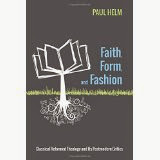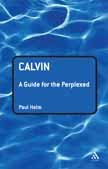We saw in the
earlier post that Dr Rob Lister in his newly-published God is Impassible and Impassioned: Toward a Theology of Divine Emotion,
adopts a ‘duality model’ of the
divine nature and activities. God apart from creation is timelessly eternal,
but upon creating the universe he ‘enters’ our universe and becomes temporal, in
the same sense as we are, and as a consequence may interact with men and women
in time. It was objected that this is seriously at variance with the classical
theism of Christian tradition, including the Reformers and Reformed Orthodox
and their Confessional positions. (Dr Lister believes that this tradition
largely anticipates his own position. I doubt this, but we shall not consider
these historical questions at this point, and no promises!) The problem with this proposal is
that it leads to a basic hiatus in theism, since it generates a series of
contradictions.
In this post I
turn attention to the consequences of this duality for ‘A Theology of Divine
Emotion’. Note that Dr Lister uses two terms of God, ‘impassible’ and
‘impassioned’. The first refers to God in
se, eternal God. In his eternality, God is impassible. He is (or becomes)
impassioned in re, according to the
author, in the following carefully-qualified sense: God is subject to passion
only in the sense that he voluntarily allows himself to have passions. He does
not have passion otherwise. He can never be ‘overtaken’ by the onset of a mood
or passion. In play here is Bruce Ware’s idea that besides God’s ontological
immutability, his necessary immutability, and then that God is immutable in the
sense that he resolves to be so. (Bruce A. Ware, ‘An Evangelical Reformulation
of the Doctrine of the Immutability of God’ Journal
of the Evangelical Theological Society, (1986), God’s Greater Glory, 140f.)
So the second
term, ‘impassioned’, refers to God’s activity in time, God in re, his voluntary responsiveness to his creation, and especially
to his covenant people. (See the discussion of these very points in Ware, God’s Greater Glory, 134f.)
I agree with Dr
Lister that an adequate account of God’s Christian theism must involve both his
transcendence and his immanence. Otherwise either deism or pantheism. So (Lister goes on) ‘divine
passion’ must include both these elements, God’s essential impassibility an
aspect of his transcendence, and his passionate engagement with his creation,
and particularly with his covenant people, an aspect of his immanence. But to
achieve this we do not need to go to the lengths of supposing a duality in God
with respect to time, or with respect to space.
Some of the case
for God’s duality in respect of time is taken by him from an account of his
two-fold account of space. God transcends space, but also he enters space (and
this expression does not refer to the Incarnation, or not exclusively to the
Incarnation, as one might think). Lister says
We
may begin this theological reflection [on God’s relation to time] with a glance
at another instructive and parallel doctrinal duality, namely, God’s
relationship to space. On this point, it is very common for Christian
theologians to understand God as both nonspatial in himself and omnipresent
within his creation. That is to say, Scripture readers recognize that though
God is present (indeed omnipresent) within his creation, this does not
diminish the fact that, in himself and apart from creation, God transcends
spatial existence and limitation. His intrinsic spacelessness therefore does
not preclude his acting within space. It is not within the purview of creation
to lock its Creator – who transcends space in himself – out of creation. (227) (At
such points he closely follows Bruce Ware, God’s
Greater Glory, 134 f.)
So there are divine dualities in respect of time, these
dualities having their precedent in God’s relation to space and being modelled
on it.
But God does not
‘enter into relationship with the world’ as you and I may enter the room. In
entering the room we enter the space of the room, and leave the space outside
the room. But I do not see that to give an account of God’s relation with his
creation we need to think of him in a similar fashion.
Greater clarity is needed here, at a central focus of
Lister’s discussion. For in discussing God’s relation with time Lister notes
the view of William Lane Craig, according to which God is eternal apart from the
creation, and then upon the creation, he is temporal. That is, there is a kind
of ‘successiveness’ in God and time: eternal ‘until’ the creation, and temporal
thereafter. Lister notes the difference between Craig’s view and the ‘duality’
view of Frame and Ware which he follows, as ‘slightly different’, and goes on to say that he finds this view
‘compelling’ (226-7 footnote 25). But
these two views, the ‘successiveness’ view and the ‘duality’ view are very
different. (I discuss Craig's view at greater length in Chapter 12 of the Second Edition of Eternal God (OUP, 2010))
The second point has to do with a difficulty that
Lister has with the classical view, or at least with one understanding of that
view. Contrasting my own view with his in a short excursus Lister says,
At the junction of
eternality and divine condescension, Helm argues that the accommodated
revelation of God in Scripture is given to make to appear as though God were
relating to his people in time, when in fact he is not. When addressing the
reason for accommodated revelation, Helm himself states that it “is because God
wishes people to respond to him that he must
represent himself to them as one to whom response is possible, as one who acts
in time.’ ….I disagree that the particular purpose is to make himself appear ‘as one who acts in
time’ and ‘as one to whom response is possible’. (The quote are from ‘The
Impossibility of Divine Passibility’ in The
Power and Weakness of God, ed. Nigel M, de S. Cameron, Edinburgh Rutherford
House, 133-34)
Notice the quotation that Lister provides is not a
defence of God appearing to be but not being, but of a
God who by his eternal decree reveals himself in his creation little by little.
He may act in this fashion in order to promote and ensure the response of
faith, for example, or to test men and women in other ways. So I go on to say, in the passage cited by Dr Lister,
‘If that dialogue is to be real and not make-believe, then God cannot represent
himself as wholly impassible, for then dialogue would be impossible’. (134) It
is not make-believe for God to express anger or delight in time, any more than it is when God represents
himself as one high and lifted up, wearing a robe whose train filled the temple
(Isaiah 6). Each kind of action is one of condescension, in
which in order to evoke an appropriate response from his people God represents
himself to them as angry on that occasion or as enthroned on that occasion. Why does God go
to these lengths? Part of the answer must be that in these ways he teaches his
people about themselves, about their needs and his grace in their lives.
These are the actions of the one eternal, timeless God
who as the covenant-partner of his people represents himself first as doing or
being one thing, and then another, and then another. His glorious goodness is
‘refracted’ in time according to his purposes for his people and with respect
to others. This involves the ‘little by
little’ revealing of his will or purposes to those in time and space mentioned
in the last post. In many cases these purposes are in order to test them: as
with Abraham, or Moses, or Hezekiah, or Jonah, or Paul. In order to grasp this
we need to see that the timeless God may will appearances of himself in timely
fashion, in successive changes and responses, now this and then that. So God
does not enter time in respect of his essence, nor does he enter the world as
one might enter a room, not even in the Incarnation in which he takes to
himself a human nature, but his power and grace reach to each corner of his
creation as he sees fit, and little by little through time. Such an arrangement is of course beyond our
wit to understand, but it is not manifestly incoherent. More importnat it expresses and coheres with many a Scriptural narrative.
This takes us back to impassibility. God is able to
represent himself as angry, or compassionate, or faithful, because in his
glorious essence he is not impassive or indifferent in character, but eternally
impassioned, and so never overcome with passion. (Here I use the same term as
Lister, ‘impassioned’, but to refer to his eternal essence. God is eternally impassible
and yet impassioned. Lister himself recognizes these differences in the usage
of the term.(161)) With these resources God is able to express first this
passionate state and then that passionate state as part of this process of
teaching and disciplining his people, drawing out their faith in his promises
and strengthening them in so doing.
So I agree with Dr Lister that God is both impassible
and impassioned. But on this understanding these terms do not refer to
God’s ‘duality’, however understood, but both together are true of the one eternal,
all-glorious God. He is eternally, in himself, both impassible,
not being subject to moods or swings or surges of any kind, and impassioned,
fully caring and concerned, and capable fo expressing such 'impassions' in time.
The oddity is that in more than one place Dr Lister
reveals sympathy with such an outlook. For example he quotes Ware as stating
that ‘the contingent emotions of God are new expressions of what are, in God
eternally, fixed emotional properties…’ (225-6) and Frame as stating that ‘God’s
eternal decree does not change, it does ordain change. It ordains a
historical series of events….’.(239) But
for some reason he does not see (nor perhaps do some others) that these views do not require a ‘duality
model’, but are easily integrated into the
classical view.








